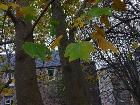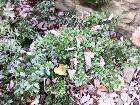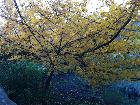Up until three days ago, I didn't even know of the existence of the 17th century physic garden on Edinburgh’s Royal Mile known as Dunbar's Close. Shame on me! But then, on Thursday, I made what Winne the Pooh might call an 'expotition' to explore Edinburgh's best-kept horticultural secret.

Corner of a parterre - or partition, with rue leaves visible
Inspired by 17th century physic gardens, Dunbar’s Close contains many of the plants that would have been grown in that period specifically for medicinal use. It was created in the 1970s by restoration charity The Mushroom Trust, next door to Canongate Kirk. After we located the unpromising entrance, we ventured over the cobble stones to the garden itself. What a delight! We were all entranced by the neatly laid out box hedges, gravel paths and lovingly-tended plants. It was all the more enchanting for being so unexpected.

The tulip-shaped leaves that give this tree its name
The trip was part of an ethno-botany course I'm taking separately to the herbology diploma. We started by learning about what turned out to be a tulip tree (Liriodendron tulipifera), named after the shape of its leaves. When our tutor, Catherine Conway Payne, asked us if we recognised the tree, I nearly made the mistake of calling out that, yes,it was a plane tree. After learning that it was, in fact, a tulip tree, I was glad I’d kept quiet. Our tutors explained that the tree is used medicinally in a decoction, by boiling up the bark.

Butcher's broom - used for sweeping out shop floors
We also met Ruscus aculeatus (butcher’s broom), with its unusual leaves and bright red berries. Butchers really did use the plant’s spiky branches for sweeping out their floors and shop windows, hence the name. The spikes were useful for picking up dead flies and ‘gobbets of flesh'.
Feeling like we were on holiday, we headed down a slope, past the beautiful box hedges surrounding central balls of yew tree, to look at lovage (Levisticum officinalis), honeysuckle (growing on the trellis), and fig (Ficus carica), growing against the wall bordering the graveyard of Canongate Kirk. Round the corner, we looked at winter jasmine (Jasminum nudiflorum).

An Elizabethan favourite, the medlar tree
Time then to make our way to the Long Border, looking east towards Holyrood Palace. Here, I was thrilled to discover a medlar tree (Mespilus germanica). We’ve been working on a project involving Elizabethan uses for autumnal berries and the medlar (a fashionable Elizabethan fruit) was one of the plants we could study. I actually copped out a little bit by choosing to focus on better-known fruit trees; elderflower, hawthorn and quince for the project, but it was great to see the medlar tree had a home at Dunbar’s Close.
We also examined some low clumps of green leaves underneath the medlar. These turned out to be Hepatica nobilis (liverwort) – a classic example of the Doctrine of Signatures, pointed out our tutors. The Doctrine of Signatures is a theory that suggests that divine providence made plants in the shape of the bodily organ they could heal. Yes, liverwort’s lobed parts really do make it look uncannily like a human liver, we decided.
We also identified Artemisia abroatanum (Southernwood) in the same parterre (the word just means partition) as the liverwort and medlar, while breathing in the soothing fragrance of a border made up entirely of Lavandula angustifolium (old lavender). Heaven.